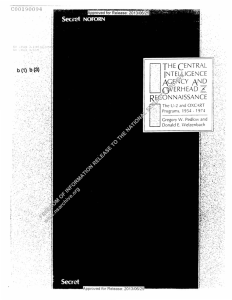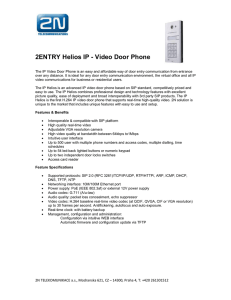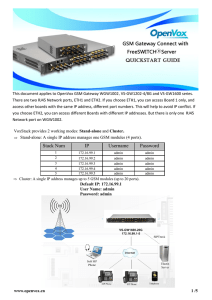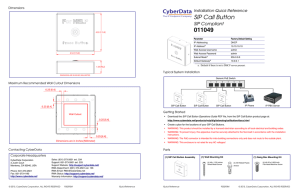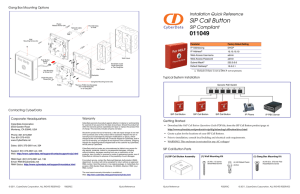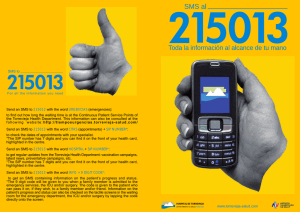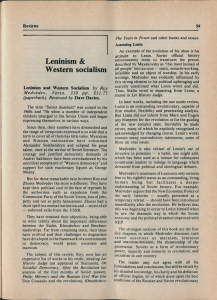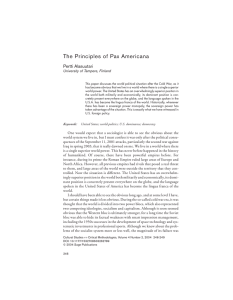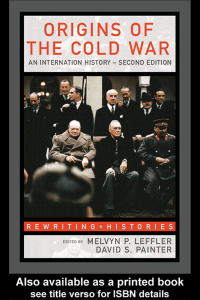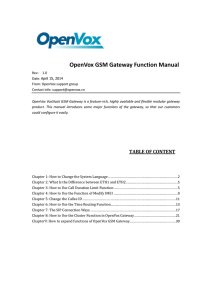Chapter 7 - National Security Archive
Anuncio
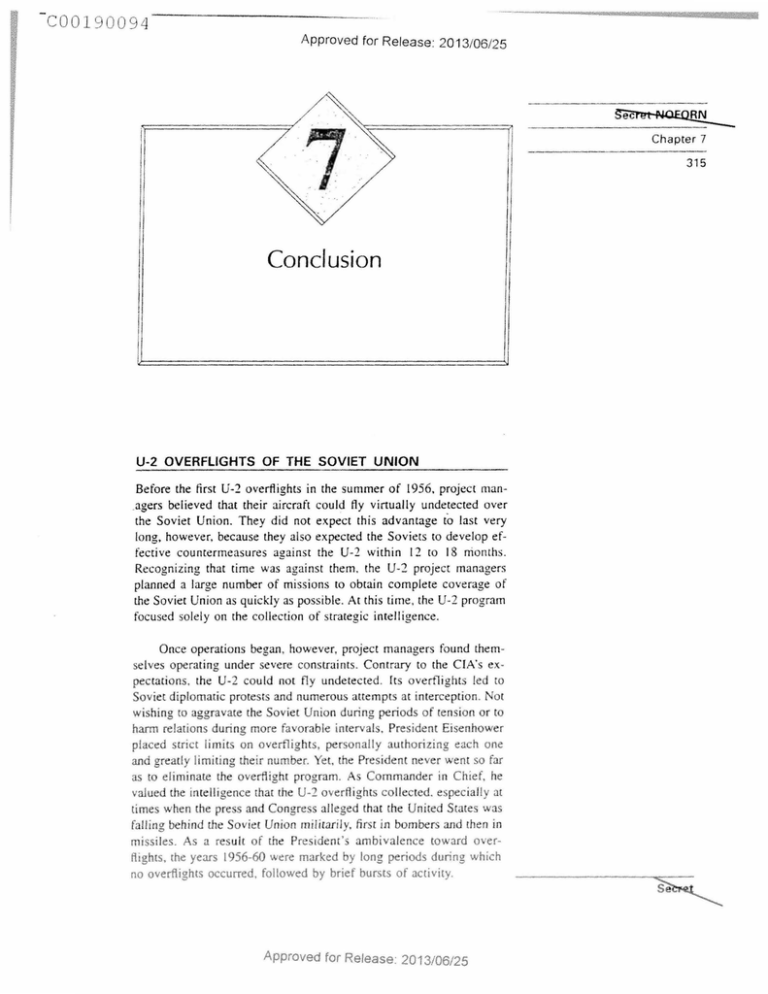
C0019009 4 Approved for Release: 2013/06/25 ~ Chapter 7 315 Conclusion U-2 OVERFLIGHTS OF THE SOVIET UNION Before the first U-2 overflights in the summer of L956. project man_agers believed that their aircraft could fly virtually undetected over the Soviet Union. They did not expect this advantage to last very long. however, because they also expected the Soviets to develop effective countermeasu res against the U-2 within 12 to 18 months. Recognizing that time was agai nst them. the U-2 project managers planned a large number of missions to obtain complete coverage of the Soviet Union as quickly as possible. At this time, the U-2 program focused solely on the collection of strategic intelligence. Once operations began, however, project managers found themse lves operating under severe constraints . Cont rary to the C IA's expectatio ns. the U- 2 could not fly undetected. fts overfl ights led to Soviet diplomatic protests and numerous attempts at in terception. Not wishing ro aggravate the Soviet Union during periods of tension or to hann relations during more favorable in tervals, President Eisenhower placed strict li mits on overflights, personally authorizing each one and greatly limiting their number. Yet, the President never went so far as ro elim inate the overflight program. As Commander in he val ued the intell igence that the U-2 overflights co llected. espec iall y at times when the press and Congress alleged that the United States was falling behind the Soviet Union mil irarily, first in bombers and then in missi les. As a res ul t of the President 's ambiva lence toward overflights, rhe years 1956-60 were marked by long periods during which no overflights occurred, followed by brief bursts of activity. Approved for Release: 2013i06/25 001 00 4 Approved for 201 316 The low level of overflight did not prevent the U-2 from accomplishing a lot in the four years it flew over the Soviet Union and Eastern U-2 missions made deep penetration of the Soviet Union: six by Detachment A from three by Detachment C from the Far East and Alaska. and 15 by Detachment 8 from Turkey and Pakistan. including the unsuccessful Powers mission. The amount of information these missions gathered was impressive. By the summer of 1960, the U-2 project had developed more than l, 285.000 feet of film-a strip almost 250 miles long. The U-2s covered more than l ,300,000 square miles of the Soviet Union, ap· proximately 15 percent of its total area. [nformation from U-2 photographs was used to prepare separate photoanalytical reports.' Numbers alone cannot describe the importance of the U-2 overflight project. In a 28 May 1960 memorandum, after Powers was shot down. DCI Allen W. Dulles described the program's accomplishments: '-Five years ago. before the beginning of the U-2 program .... half knowledge of the Soviet Union and uncertainty of its true power position posed tremendous problems for the United States. We were faced with the constant risk of exposing ourselves to enemy attack or of needlessly expending a great deal of money and effort on misdirected military preparations of our own." Dulles wenc on to describe the U-2's contribution in information on four critical asof the Soviet Union's power position: its bomber force, its misits atomic energy program. and its air defense system. 001 00 4 Approved for 201 --~-------~ Chapter 7 317 The "bomber-gap" controversy was soon followed by a "missile-gap" controversy, provoked by an extensive Soviet propaganda campaign that claimed a substantial Soviet lead in developing and deploying lCBMs. U-2 missions searched huge stretches of the Soviet Union the rail for ICBMs deployed outside the known missile testing facilities. These missions enabled the ClA to conclude, as Dulles explained to Congress in May 1960, that "the Soviet ICBM program has not been and is not now a crash program; instead, it is an orderly, well-planned, high-priority program aimed at 3 achieving an early ICBM operational capability." As with the controversy over Soviet bomber strength, information from U-2 photography enabled President Eisenhower m resist pressure £O accelerate the US missile deployment program by building obsolescem liquid-fueled missiles rather than waiting to complete the development of more reliable solid-fueled missiles. U-2 missions also gathered considerable dam on the Soviet Union's atomic energy program. including the production of fissionable materials. weapons development and testing activities, and the location and size of nuclear weapons stockpile sites. Such U-2 photography also revealed no evidence that the Soviet Union had violated the nuclear testing moratorium. One of the greatest contributions of the U-2 program was to increase the capabilities of the US deterrent force. Before the U-2 overinformation was based on obsolete materials nights, most thereafter. With the assistance back to World War II or of U-2 the Defense Department could allocate weapons and ~2 001 00 4 Approved for Release: 2013/06/25 Chapter 7 318 The U-2 program not only provided information on individual Soviet weapons systems, but also helped analysts assess basic Soviet intentions, particularly during crisis situarions, as Dulles wrote in May 1960: Whenever the international situation becomes tense because of a problem in some particular area, we are concerned whether the situation might get beyond conrrol-thar someone on the other side might suddenly and irrationally unleash big war., .. Our knowledge of Soviet military preparations, however, resulring from the oveiflight program, has given us an ability to discount or call the bluffs of the Soviets with confidence. We have been able to conclude that Soviet statements were more rhetorical than threatening and that our courses of action could be carried through without serious risk of war and without Soviet 4 inteiference. Dulles closed his report on the U-2's accomplishments by putting the program in perspective as part of the entire national intelligence effort, noting that "in terms of reliability, of precision, of access to otherwise inaccessible installations, its contribution has been unique. And in the opinion of the military. of the scientists and of the senior officials responsible for our national security it has been, to put it simply. invaluable." The impact of the U-2 overflights on international re!acions is harder to measure. On the one hand, the intelligence they gathered was a major factor in keeping the United States from beginning a and destabilizing arms race in the late 1950s and early 1960s that the Soviet Union was not in major buildups bombers and intercontinental ballistic missiles. On the COOl 4 Approved for 3/06/25 319 PARTICIPATION OF AlliES IN THE U-2 PROGRAM From the very beginning of the overflight project, US Allies valuable support. Bases in Germany, the Soviet Union. Bases in India, played a major role in overflights Thailand, Japan, and rhe Philippines greatly assisted operations in Asia. Two Allies-the United Kingdom and Nationalist China-made an even contribution to the U-2 program by providing pilots and conducting overflights. British pilms began flying in late 1958 and conducted two important overflights of the Soviet Union in late 1959 and early 1960. After the end of such missions in May 1960, the need for British participation lessened. RAF pilots henceforth flew only or ferry missions, although their use for operational missions was considered on several occasions. The end of overflights of the Soviet Union reduced the importance of British participation but resulted in the addition of a new source of pilots when the focus of interest for the U-2 in its strategicintelligence-gathering role shifted to the People's Republic of China. The United States and Nationalist China had been conducting joint r~l;onnaissance projects over the Chinese mainland since the mid-l950s, and in 1961 the CIA equipped the Nationalist Chinese with the latest in reconnaissance aircraft, the U-2. For the next 12 years, U-2s with Nationalist Chinese pilots brought back quantities of information on the development of Communist China's armed forces, nuclear technology, and economy. Such information was extremely important to US policymakers. Nationalist China paid a high in lives for its participation in the U-2 seven pilots died in accidents and two on and another three were ""''"u,, "'u AS COLLECTORS OF TACTICAl INTElliGENCE Approved for Release: 2013/06/25 ;;~ Chapter 7 320 involvement in Indochina, U-2 photography provided accurate and to US and field commanders, asup-to-date them in crisis management and the planning of milimry operations. U-2s also assisted in monitoring cease-fire agreements in the Middle East, with operations after an undeclared \var in 1970 and the !973 Middle East war. By the time the OXCART became fully operationaL manned strategic reconnaissance of the Soviet Union was no longer seriously considered. The political risks were too high. especially since the quality of intelligence from reconnaissance satellites was increasing steadily. Thus, the OXCART's only operational use was for collecting the OXCART gathtactical intelligence in the Far East. Like the en:~d valuable intelligence during crisis situations. Thus. in January !968. OXCART photography revealed the locarion of the USS Pueblo and showed thac the North Koreans were not preparing any military activity in conjunction with the seizure. ADVANCES IN TECHNOLOGY One very important byproduct of the CIA's manned reconnaissance program was the many advances in technology that it generated. Thanks to simplified covert procurement arrangements and the lack of detailed and restricting specifications. creative designers such as Kelly Johnson produced aircraft in record time. The U-2. to carry out reconnaissance missions for two years at best. proved so successful that, even after its original area of activity became too for at the end of four years, the airand still is in service served the well for another 14 4 Approved for Release: Chapter 7 321 government could not afford to maintain two such similar reconnaisOXCART program sance programs. The elimination of the did not, however, spell the end of the usefulness of the world's most advanced aircraft; its offspring, the SR-71, is still in service. In addition to the aircraft themselves, many other items associated with the reconnaissance program have represented important advances in technology. The flight suits and life-support systems of the U-2 and OXCART pilots were the forerunners of the equipment used in the space program. Camera resolution improved dramatically as the result of cameras and lenses produced for the CIA's reconnaissance program. COOPERATION WITH THE AIR FORCE In this history, which concentrates on the CIA's involvement in overhead reconnaissance, it is easy to overlook the important role that the US Air Force played in the U-2 and OXCART programs. From the very beginnings of the U-2 program in 1954, the Agency and the Air Force were partners in advancing the state of the art in overhead reconnaissance. Air Force personnel served at all levels of the reconnaissance program, from project headquarters to the testing site and field detachments. The Air Force supplied the U-2's engines, at times diverting them from other high-priority production lines. Perhaps most important of all, the Air Force provided pilots for the U-2s after the original attempt to recruit a sufficient number of skilled pilots proved unsuccessfuL Finally, the day-to-day operations of the U-2s could not have been conducted without the help of Air Force mission weather and the detachments. IMPACT THE OVERHEAD RECONNAISSANCE PROGRAM ON THE CIA COOl 4 Approved for Release: 2013/06/25 322 technical means of collection. As soon as the U-2 began flying over the Soviet Union, irs photographs became the most important source of intelligence available. The flood of information that the U-2 missions gathered led to a major expansion of the photoimerpretation capabilities. which finally resulted in the creation of the National Photographic fnterpretation Center to serve the entire intelligence community. The U-2's tremendous success as an intelligence-gathering system led the Agency to search for follow-on systems that could continue to obtain highly reliable information in large quantities. Thus. the CIA sponsored the development of the world's most advanced aircraft-the OXCART-and also pioneered research into photosatellites. Less than a decade after the U-2 program began, the Agency's new emphasis on technical means of collection had brought about the creation of a new science-oriented directorate, which would ultimately rival in manpower and budget the Agency's other three directorates combined. The negative aspect of this new emphasis on technology is exploding costs. The Agency's first strategic reconnaissance aircraft, the U-2, cost less than S I million apiece. With the U~2's successor, the OXCART, each aircraft cost more than $20 million. and the cost explosion has continued with each new generation of reconnaissance satellites. Perhaps the of the CIA's into the world of overhead reconnaissance in December !954 was the new na~ US aircraft had Frein the decade after World War

